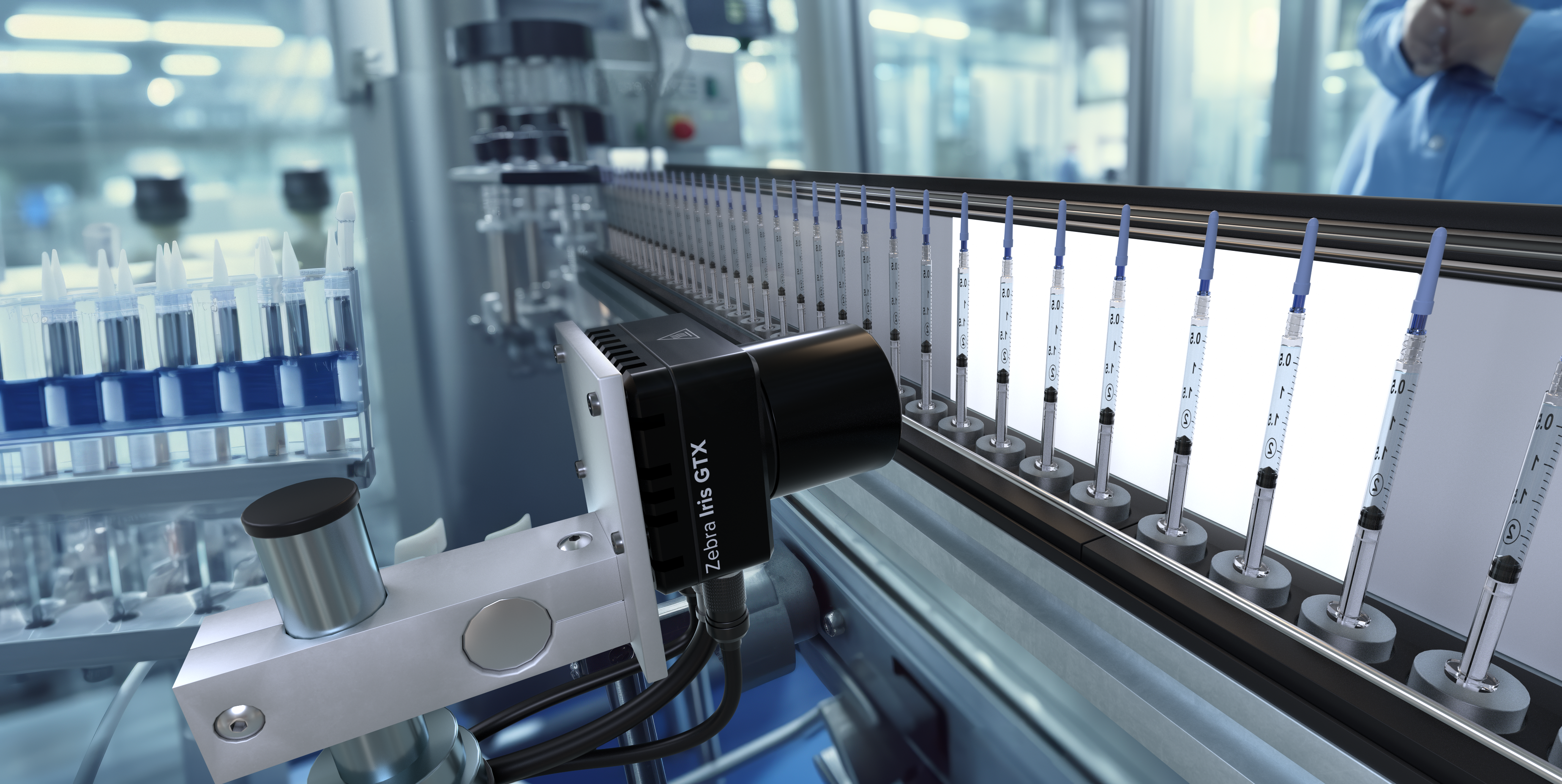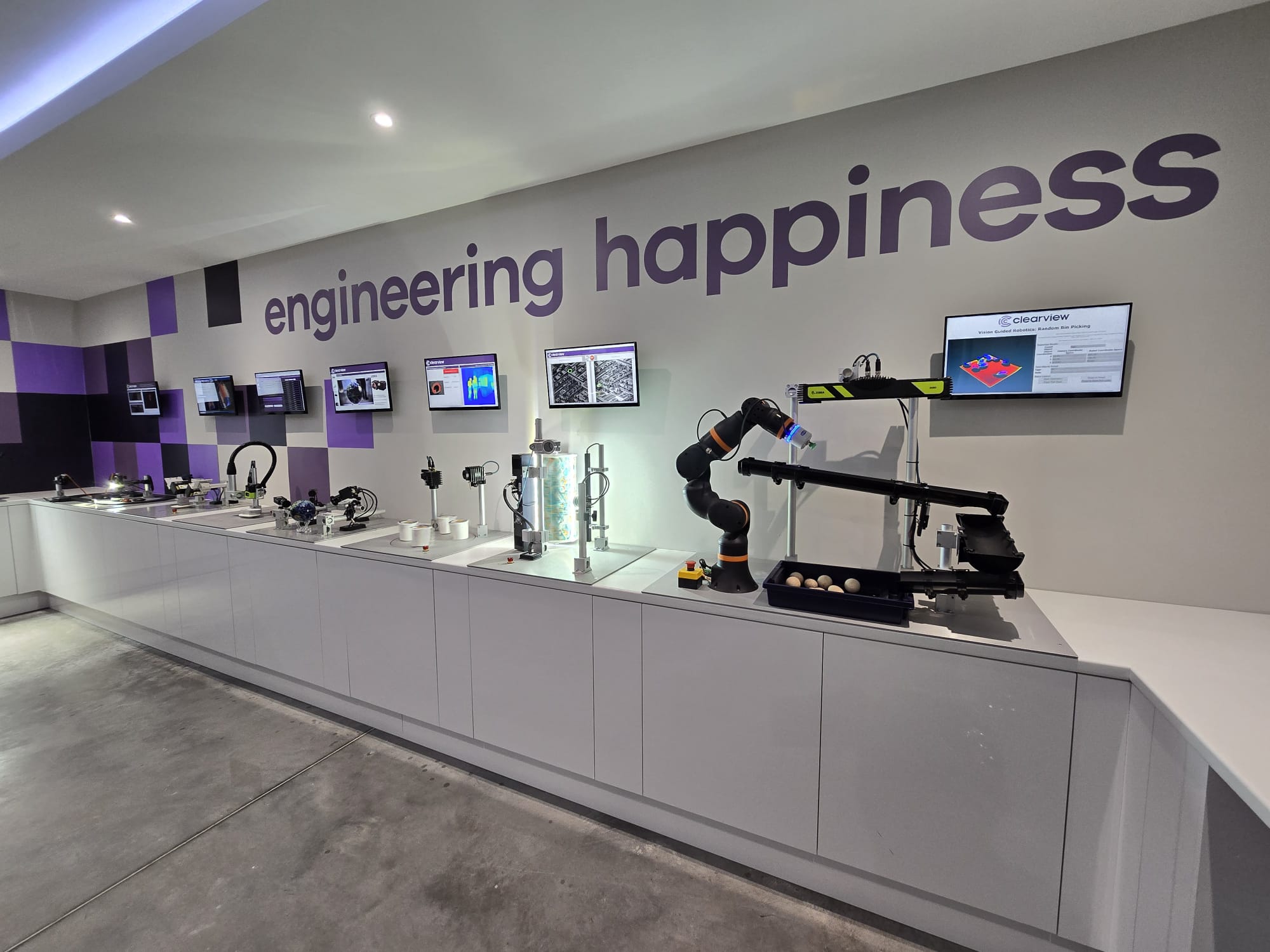Transform retail operations with Zebra’s retail technology solutions, featuring hardware and software for improving inventory management and empowering teams.
Streamline operations with Zebra’s healthcare technology solutions, featuring hardware and software to improve staff collaboration and optimize workflows.
Enhance processes with Zebra’s manufacturing technology solutions, featuring hardware and software for automation, data analysis, and factory connectivity.
Zebra’s transportation and logistics technology solutions feature hardware and software for enhancing route planning, visibility, and automating processes.
Learn how Zebra's public sector technology solutions empower state and local governments to improve efficiency with asset tracking and data capture devices.
Zebra's hospitality technology solutions equip your hotel and restaurant staff to deliver superior customer and guest service through inventory tracking and more.
Zebra's market-leading solutions and products improve customer satisfaction with a lower cost per interaction by keeping service representatives connected with colleagues, customers, management and the tools they use to satisfy customers across the supply chain.
Empower your field workers with purpose-driven mobile technology solutions to help them capture and share critical data in any environment.
Zebra's range of Banking technology solutions enables banks to minimize costs and to increase revenue throughout their branch network. Learn more.
Zebra's range of mobile computers equip your workforce with the devices they need from handhelds and tablets to wearables and vehicle-mounted computers.
Zebra's desktop, mobile, industrial, and portable printers for barcode labels, receipts, RFID tags and cards give you smarter ways to track and manage assets.
Zebra's 1D and 2D corded and cordless barcode scanners anticipate any scanning challenge in a variety of environments, whether retail, healthcare, T&L or manufacturing.
Zebra's extensive range of RAIN RFID readers, antennas, and printers give you consistent and accurate tracking.
Choose Zebra's reliable barcode, RFID and card supplies carefully selected to ensure high performance, print quality, durability and readability.
Zebra's location technologies provide real-time tracking for your organization to better manage and optimize your critical assets and create more efficient workflows.
Zebra's rugged tablets and 2-in-1 laptops are thin and lightweight, yet rugged to work wherever you do on familiar and easy-to-use Windows or Android OS.
With Zebra's family of fixed industrial scanners and machine vision technologies, you can tailor your solutions to your environment and applications.
Zebra’s line of kiosks can meet any self-service or digital signage need, from checking prices and stock on an in-aisle store kiosk to fully-featured kiosks that can be deployed on the wall, counter, desktop or floor in a retail store, hotel, airport check-in gate, physician’s office, local government office and more.
Adapt to market shifts, enhance worker productivity and secure long-term growth with AMRs. Deploy, redeploy and optimize autonomous mobile robots with ease.
Discover Zebra’s range of accessories from chargers, communication cables to cases to help you customize your mobile device for optimal efficiency.
Zebra's environmental sensors monitor temperature-sensitive products, offering data insights on environmental conditions across industry applications.
Enhance frontline operations with Zebra’s AI software solutions, which optimize workflows, streamline processes, and simplify tasks for improved business outcomes.
Zebra Workcloud, enterprise software solutions boost efficiency, cut costs, improve inventory management, simplify communication and optimize resources.
Keep labor costs low, your talent happy and your organization compliant. Create an agile operation that can navigate unexpected schedule changes and customer demand to drive sales, satisfy customers and improve your bottom line.
Drive successful enterprise collaboration with prioritized task notifications and improved communication capabilities for easier team collaboration.
Get full visibility of your inventory and automatically pinpoint leaks across all channels.
Reduce uncertainty when you anticipate market volatility. Predict, plan and stay agile to align inventory with shifting demand.
Drive down costs while driving up employee, security, and network performance with software designed to enhance Zebra's wireless infrastructure and mobile solutions.
Explore Zebra’s printer software to integrate, manage and monitor printers easily, maximizing IT resources and minimizing down time.
Make the most of every stage of your scanning journey from deployment to optimization. Zebra's barcode scanner software lets you keep devices current and adapt them to your business needs for a stronger ROI across the full lifecycle.
RFID development, demonstration and production software and utilities help you build and manage your RFID deployments more efficiently.
RFID development, demonstration and production software and utilities help you build and manage your RFID deployments more efficiently.
Zebra DNA is the industry’s broadest suite of enterprise software that delivers an ideal experience for all during the entire lifetime of every Zebra device.
Advance your digital transformation and execute your strategic plans with the help of the right location and tracking technology.
Boost warehouse and manufacturing operations with Symmetry, an AMR software for fleet management of Autonomous Mobile Robots and streamlined automation workflows.
The Zebra Aurora suite of machine vision software enables users to solve their track-and-trace, vision inspection and industrial automation needs.
Zebra Aurora Focus brings a new level of simplicity to controlling enterprise-wide manufacturing and logistics automation solutions. With this powerful interface, it’s easy to set up, deploy and run Zebra’s Fixed Industrial Scanners and Machine Vision Smart Cameras, eliminating the need for different tools and reducing training and deployment time.
Aurora Imaging Library™, formerly Matrox Imaging Library, machine-vision software development kit (SDK) has a deep collection of tools for image capture, processing, analysis, annotation, display, and archiving. Code-level customization starts here.
Aurora Design Assistant™, formerly Matrox Design Assistant, integrated development environment (IDE) is a flowchart-based platform for building machine vision applications, with templates to speed up development and bring solutions online quicker.
Designed for experienced programmers proficient in vision applications, Aurora Vision Library provides the same sophisticated functionality as our Aurora Vision Studio software but presented in programming language.
Aurora Vision Studio, an image processing software for machine & computer vision engineers, allows quick creation, integration & monitoring of powerful OEM vision applications.
Adding innovative tech is critical to your success, but it can be complex and disruptive. Professional Services help you accelerate adoption, and maximize productivity without affecting your workflows, business processes and finances.
Zebra's Managed Service delivers worry-free device management to ensure ultimate uptime for your Zebra Mobile Computers and Printers via dedicated experts.
Find ways you can contact Zebra Technologies’ Support, including Email and Chat, ask a technical question or initiate a Repair Request.
Zebra's Circular Economy Program helps you manage today’s challenges and plan for tomorrow with smart solutions that are good for your budget and the environment.
The Zebra Knowledge Center provides learning expertise that can be tailored to meet the specific needs of your environment.
Zebra has a wide variety of courses to train you and your staff, ranging from scheduled sessions to remote offerings as well as custom tailored to your specific needs.
Build your reputation with Zebra's certification offerings. Zebra offers a variety of options that can help you progress your career path forward.
Build your reputation with Zebra's certification offerings. Zebra offers a variety of options that can help you progress your career path forward.

Want to Be 100% Sure You’re Printing Accurate Labels …Before They Come Off the Printer?
Editor’s Note: This post was originally published July 13, 2020. It was updated May 2024 to reflect the latest verification tools available to you.
###
Product labeling operations in the pharmaceutical industry are extremely complex—and rightly so. There is so much information that must be squeezed into a tiny space on prescription bottles and cardboard packages, including dosing instructions, ingredient lists, potential side effects, usage warnings and other patient safety guidance – and there is no margin for error.
It is imperative that the label information is correct and accurate every time it comes off the printer, before it is affixed to the packaging. Even a single error can render the product defective and lead to its removal from the market, which can severely damage reputations, disqualify suppliers and even threaten lives.
Therefore, every label must be thoroughly inspected for accuracy and readability. But not just by pharmaceutical companies and their supply chain partners. Manufacturers of all consumable products, including food and beverage items, are required to comply with strict label quality standards, as are those who produce health and beauty products, medical equipment and chemical products.
The challenge is that not all companies have the right tools to efficiently conduct these inspections, particularly in-line inspections that can identify issues at the point-of-printing to minimize – or completely eliminate – labeling-related production disruptions.
What You Need to Quickly and Accurately Verify Label Quality In-Line (While Labels are Still in the Printer)
No one wants to have to stop their production line to correct product labeling issues. That is why in-line verification systems are so valuable: they automatically identify and flag issues with registration, streaking or voids as the labels are being printed and applied so that plant floor workers can monitor for – and quickly correct – any issues before defective labels make it too far down the production line and stop all production. However, waiting until the label is done printing and/or applied to the product to verify compliance is risky. Oversights can happen and mislabeled products can accidentally make it out into the market.
The best way to mitigate quality control issues in real time and improve label compliance is to integrate the in-line verification system into the label printer itself. Doing so will help catch print quality errors before the label reel passes the point of rewinding. It will also help find labeling errors that are too subtle or impossible for the human eye to identify.
If an issue is detected by the printer during the in-line verification process, the operator can quickly conclude that it is the result of inconsistencies in the printing method and immediately adjust the printing method to achieve the desired quality. These types of in-line verification systems also enable manufacturers to observe print quality and verification grade trends so that the production line can be altered accordingly for optimum print output.
Which Type of In-Printer In-Line Verification System is Best-Suited for Your Labeling and Production Environment?
Many industrial printers are already engineered to print the desired label at the required compliance level without the need for additional verification. However, if you have critical applications that demand 100% label accuracy, then you may want to consider integrating an in-line verification solution for that enhanced quality control monitoring during the printing process. Just know that many in-line verification systems are actually offered as third-party integrations approved and tested by the original printer manufacturer (OEM).
If you’re using a Zebra industrial printer for your labeling applications and want to add in-line verification capabilities to your printer, you may want to take a look at one of the integrated third-party tools listed below. They are all confirmed by Zebra to be compatible with our printers, including our ZT600 premium industrial printers, which means they meet the same strict performance and quality standards that we apply to our proprietary printing solutions:
1. Perceptor IoT, which is a software application that inspects thermal transfer printed labels in real-time to detect print blemishes, quality defects, duplicates and non-compliant labels. Leveraging custom Zebra firmware, Perceptor IoT comprises a desktop IoT device connected to the Perceptor inspection camera which integrates with the Zebra ZT610. An extensive range of label inspection and verification features – including barcode grading, pattern match, OCR/OCV, ISO content validation, serialization control and audit trail – is easily enabled through the Perceptor licence key. Secure global connectivity is assured through Azure Single Sign On (SSO) or machine to machine self-signed certificates. No technical knowledge is required to integrate with new or existing Zebra printers, and three software editions and two licence types make Perceptor IoT suitable for both compliant and non-compliant industries. Watch this installation video to see how easy it is to set up:
2. The Omron LVS V275 Print Inspection System from Omron Microscan Systems can be integrated into the Zebra ZT610 printers to identify print faults such as skews, smears, registration errors, die-cut errors and missing information. The V275 verifies 1D and 2D barcode quality to ISO/IEC 15416/15415 standards and can check for GS1 syntax. It leverages features such as Optical Character Verification (OCV) to ensure that a string of sequential characters is read and/or verified against a known field or database. It also has Data and Code Matching to verify encoded data and ensure synchronicity of multiple fields within a label, which is valuable in pharmaceutical and medical device manufacturing, consumer goods packaging and specialty chemical manufacturing.

3. BLC Solutions is an agile barcode verification solution from Richvoice, which leverages its flexibility to integrate with a wide range of Zebra industrial printer models. The 'built-in' hardware unit seamlessly incorporates into the printer without the need for any encoder. Recent developments include addressing requirements related to RFID tags and serialized barcodes, in addition to basic features such as tear-off, rewinder, peel-off, cutter, and applicator. A customizable data capture and reporting system permits users to effectively analyze and identify root causes for continuous improvement purposes. It is mainly used in automotive, medical device, and electronics manufacturing environments.
Final Note:
Although Zebra’s industrial printers do not provide proprietary in-line verification, they are optimized to work with in-line verification solutions from several third-party solution providers, including those listed above who have successfully integrated their solutions into Zebra printers for customers in the past. By offering the in-line verification solution as an added integration versus standard OEM feature, we are helping to ensure that you can select the right tool for your specific labeling application and inspection/compliance requirements.
Feel free to contact us if you need assistance determining which integrated solutions are compatible with your Zebra printer and best-suited for your application.
You can also learn more about the ZT600 Perceptor IoT Verifier solution and key features in the two videos below:

Alex Holdsworth
Alex Holdsworth is currently an EMEA Regional Product Manager where he is responsible industrial printers and scanners in addtion to Zebra DNA software for printers and scanners.
Alex has been a regional product manager in EMEA his whole working career. He was previously a product management intern at Zebra before returning to Newcastle University to finish his Computer Science degree. Alex rejoined Zebra in 2019 as a part of the graduate scheme and has been involved in product management since, looking after a diverse portfolio of mobile computers, printers, and scanners.
Zebra Developer Blog
Zebra Developer BlogZebra Developer Blog
Are you a Zebra Developer? Find more technical discussions on our Developer Portal blog.
Zebra Story Hub
Zebra Story HubZebra Story Hub
Looking for more expert insights? Visit the Zebra Story Hub for more interviews, news, and industry trend analysis.
Search the Blog
Search the BlogSearch the Blog
Use the below link to search all of our blog posts.
Most Recent
Legal Terms of Use Privacy Policy Supply Chain Transparency
ZEBRA and the stylized Zebra head are trademarks of Zebra Technologies Corp., registered in many jurisdictions worldwide. All other trademarks are the property of their respective owners. ©2025 Zebra Technologies Corp. and/or its affiliates.






